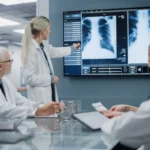Whether you are currently working in the field of medicine and healthcare and are looking to move into a nursing role, or else are involved in another industry entirely and have always been interested in becoming a nurse, then you have certainly come to the right place.
Here, for your information and of course reading pleasure, are the main pathways into nursing and associated professions.
Nursing: RN vs LPNs
Firstly, it is important to ascertain the differences and indeed the similarities between RNs (Registered Nurses) and LPNs or LVNs (Licensed Practical Nurses).
Both RNs and LPNs are nursing roles which directly work with patients on a ‘front line;’’ and one-to-one basis are both, therefore, crucial and one of the most important components of the healthcare profession.
Registered Nurses will have either completed a Bachelor of Science in Nursing or an Associate Degree in Nursing, either in-person or through one of the accelerated nursing programs online, which all take three years to complete on a full-time basis and five years to complete part-time. Licensed Practical Nurses, on the other hand, who are sometimes otherwise referred to as Licensed Vocational Nurses are nurses who have successfully acquired an LPN certification and then go on to complete a NCLEX_RN license examination.
Licensed Practical Nurses perform the following duties and roles daily:
- The distribution of oral medication
- Helping patients with daily living
- Helping patients with toileting and bathing
- Charting vital signs
Registered Nurses conduct the above duties, as well as the following:
- Counselling patients
- Educating families and patients
- Performing extensive physical examinations
- Distributing IV medications and oral medications
- The assessment of patients
- Counselling patients and the families of patients
- Collecting blood samples
- Starting IVs
Although these are the main routes to becoming a professional and qualified nurse, there are a host of other career pathways which involve the basic similar duties and daily responsibilities which nurses have in other fields of medicine and healthcare.
The fundamental duties which are shared with other career pathways, as listed in the next sections, involve the following, to name but a few:
- Turning and moving patients
- Cleaning patients’ bed linen and rooms
- Gathering patients’ records and histories
- Taking vital signs
- Bathing and cleaning patients
- Stocking hospital and ward supplies
- Answering patients’ calls
Physical Therapist Assistant
The group of healthcare professionals who watch the movement, moods, and speech of clients for various treatment courses around physical therapy after either recovery from surgery or another operation or else after suffering a disability.
Physical therapist assistants work with a variety of different ages, nationalities, and people from all walks of life and work to build strong communications and professional relationships with the people whom they treat.
To become a physical therapist assistant, it is necessary to first successfully acquire an associate or bachelor’s degree in medicine with a specialty in physical therapy before passing the US National Physical Therapy examination.
The average annual salary for a qualified physical therapist assistant range between $47,000 and $53,000 per year.
Medical Transcriptionist
Another vital section of the healthcare profession but perhaps one which is slightly less well-known and indeed celebrated is that of the field of medical transcription.
Essentially, the role of a medical transcriptionist involves the taking of detailed notes and instructions on medical appointments in clinics with equipment which is specially designed for the treatment and recording of diseases and illnesses.
Medical transcriptionists have a wide range of different duties and responsibilities, including the organization of patient information for databases of a clinical nature, the use of classification software to categorize and code health data and maintaining utmost security, accessibility and confidentiality of medical data and patient records.
At the very least, a medical transcriptionist should hold a degree in a related medical field or extensive experience and training in the area.
The average annual salary for a qualified medical transcriptionist ranges between $52,000 and $59,000 per year.
Radiologic Technologist
Radiologic technologists, often alternatively referred to as rad techs, are specially trained in the use of specialized equipment which can help doctors, surgeons, and other physicians to determine and decide the proper check-ups and diagnoses for individual patients.
Radiologic technologists who work in healthcare facilities such as hospitals and other medical institutions are responsible for the following duties, to name a few:
- The evaluation of each produced image for accuracy and quality
- The protection of patients from any extra and wholly unnecessary radiation exposure
- The preparation of patients for diagnostic examination and imaging
- The creation and updating of thorough patient records
- Supporting patients by answering any queries, worries, concerns, and questions
- The maintenance of specialized imaging and diagnostic equipment
To become a qualified and working professional radiologic technologist, it is necessary to not only hold a bachelor’s undergraduate degree in medicine but also to become certified according to the individual state laws and guidelines.
Surgical Technologist
The role of the surgical technologist in the medical and healthcare industry again shares a host of similarities in terms of duties and responsibilities with registered nurses, but with an added emphasis on everything to do with surgical instruments and equipment.
Essentially, surgical technologists work incredibly closely with different surgeons and other physicians and prepare the room with the correct equipment and types of tools before an operation and surgery. It is an important role that is perhaps undercelebrated in public.
Some of the principal roles of a surgical technologist include:
- The anticipation of both patient and physician needs during surgery
- The participation of education and management of all staff in the operating room
- The replacement, inspection, and sterilization of every single medical device
- The participation in restocking medical and surgical supplies
- The organization and preparation of operating instruments, equipment, and supplies
- The management of medications in terms of checking the right doses and assisting with medical dressings
- Taking care of the patient before, during and after surgery
- Consistent and thorough adherence to sanitation and safety guidelines
The average annual salary for a professional surgical technologist ranges between $43,000 and $51,000 a year.
Read Also
- How Pilates Certification Enhances Professional Growth in Healthcare
 Are you looking for a way to expand your skills and stand out in healthcare? Pilates certification can be a powerful step in your professional journey. It not only helps you understand movement and body mechanics. It also gives you tools to support patient recovery. It also improves mobility, and promotes wellness. Ready to see… Read more: How Pilates Certification Enhances Professional Growth in Healthcare
Are you looking for a way to expand your skills and stand out in healthcare? Pilates certification can be a powerful step in your professional journey. It not only helps you understand movement and body mechanics. It also gives you tools to support patient recovery. It also improves mobility, and promotes wellness. Ready to see… Read more: How Pilates Certification Enhances Professional Growth in Healthcare - Understanding the Legality & Challenges in the Dental Aligner Industry
 The dental aligner industry has grown quickly in the past decade. More people are choosing clear aligners instead of traditional braces because they are less noticeable and often more convenient. While this growth has created new opportunities, it has also raised legal questions and practical challenges. Patients, dentists, and companies are still learning how to… Read more: Understanding the Legality & Challenges in the Dental Aligner Industry
The dental aligner industry has grown quickly in the past decade. More people are choosing clear aligners instead of traditional braces because they are less noticeable and often more convenient. While this growth has created new opportunities, it has also raised legal questions and practical challenges. Patients, dentists, and companies are still learning how to… Read more: Understanding the Legality & Challenges in the Dental Aligner Industry - CPR Skills: Be Ready to Act When It Matters Most
 Every year, many emergencies happen where lives are at risk and quick action is needed. One skill that can make a big difference is knowing CPR (cardiopulmonary resuscitation) and first aid. In these moments, knowing what to do can be the difference between life and death. By learning these skills, you protect yourself and become… Read more: CPR Skills: Be Ready to Act When It Matters Most
Every year, many emergencies happen where lives are at risk and quick action is needed. One skill that can make a big difference is knowing CPR (cardiopulmonary resuscitation) and first aid. In these moments, knowing what to do can be the difference between life and death. By learning these skills, you protect yourself and become… Read more: CPR Skills: Be Ready to Act When It Matters Most - Disaster Preparedness in Healthcare: Lessons from the Field
 When natural disasters, pandemics, or infrastructure failures strike, healthcare systems are often pushed to their limits. In rural and underserved areas, where resources are already stretched thin, the consequences can be especially dire. Disaster preparedness in healthcare is no longer a “nice to have” — it’s a necessity. Over the past few decades, various healthcare… Read more: Disaster Preparedness in Healthcare: Lessons from the Field
When natural disasters, pandemics, or infrastructure failures strike, healthcare systems are often pushed to their limits. In rural and underserved areas, where resources are already stretched thin, the consequences can be especially dire. Disaster preparedness in healthcare is no longer a “nice to have” — it’s a necessity. Over the past few decades, various healthcare… Read more: Disaster Preparedness in Healthcare: Lessons from the Field - Building Trust Across Distance: The Art of Leading Remote Radiology Teams with Purpose and Presence
 In today’s digital age, the way we work has changed—especially in fields like radiology, where technology allows specialists to read and interpret images from anywhere in the country. While this remote model of care has made it easier to bring expertise to underserved and rural communities, it’s also introduced new leadership challenges. Building and maintaining… Read more: Building Trust Across Distance: The Art of Leading Remote Radiology Teams with Purpose and Presence
In today’s digital age, the way we work has changed—especially in fields like radiology, where technology allows specialists to read and interpret images from anywhere in the country. While this remote model of care has made it easier to bring expertise to underserved and rural communities, it’s also introduced new leadership challenges. Building and maintaining… Read more: Building Trust Across Distance: The Art of Leading Remote Radiology Teams with Purpose and Presence






